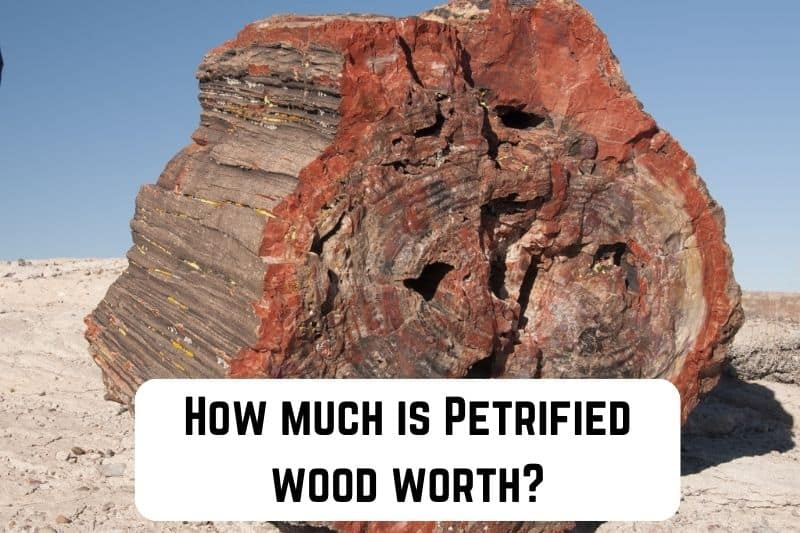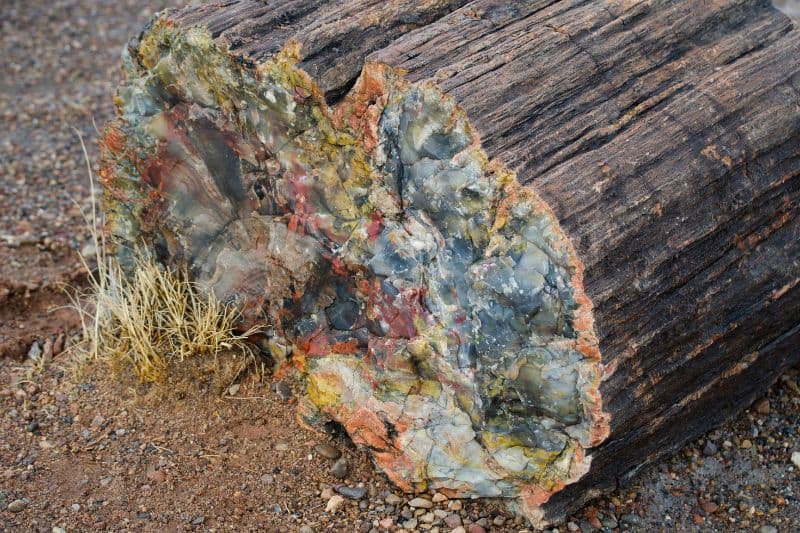How Much is Petrified Wood Worth?

Petrified wood is the fossilized remains of terrestrial vegetation. It is essentially made up of trees that are preserved and transformed into stone over millions of years. The organic material of plants is gradually replaced by minerals, and this process is called petrification.
Have you ever wondered about the value of petrified wood? In this article, we are going to discuss just that. We will begin by introducing petrified wood and then talking about the various factors that affect its price. Then, we will discuss ways of selling it in the best manner.
Read: 13+ Different Types of Black Rocks and Minerals (+Pics)
What is Petrified Wood?
Petrified wood is made up of trees that have been transformed into stone over many years. The trees’ organic material gets gradually replaced by surrounding minerals such as quartz, silica, etc., forming fossilized wood.
Petrified wood acquires its name from the Ancient Greek term πέτρα meaning “rock” or “stone”; so, it literally means “wood turned into stone”. It is the result of a tree or tree-like plant getting replaced by stone via a mineralization process.
How Much is Petrified Wood Worth Per Pound?
In general, a specimen can cost about $0.25 to $10 per pound based on quality and size. It is valuable to both collectors and jewelry makers. A rough specimen may only cost a dollar or two, but it can command much higher prices when it is polished.
However, it is important to note that the value of petrified wood depends on various factors, such as size, quality, color, etc. So, its price per pound will also be dependent on these factors.
Similarly, if the specimen is turned into furniture or incorporated into jewelry, then also it will be more expensive. So, the greater the time & effort that has been invested in the specimen, the higher its value.
How Long Does it Take to Make Petrified Wood?
Petrified wood forms through a natural process called permineralization, which takes place over millions of years. It involves the following steps:
- Burial: The process begins when a tree falls into a water body (say a river or a floodplain). It can also start when plants get buried under volcanic ash, sediment, or other debris. This burial is necessary to cut off the supply of oxygen and microbial decay, which would otherwise cause the plants to decay.
- Absorption of Minerals: Over many years, as the buried plant becomes covered by layers of sediments, it starts absorbing groundwater. This water is rich in dissolved minerals, such as silica (usually in the form of quartz), calcium carbonate, iron oxides, etc. The mineral-rich water seeps into the water, and this gradually infiltrates the tree’s cellular structure. In this way, the organic materials constituting the living wood (such as cellulose and lignin) slowly get replaced.
- Crystallization: The minerals precipitate out of the water and begin to crystallize in the empty spaces of the plant. They fill the wood’s microscopic pores, cells, and vessels, replicating its original structure on a microscopic scale. These various minerals & trace elements are responsible for the diverse colors and patterns that we see in petrified wood. Iron oxide, for example, creates red hues, while manganese produces shades of purple.
- Solidification: As more and more minerals replace the organic material, eventually, the wood hardens and solidifies. The entire structure of the tree gets transformed into stone, even as it still retains the original structure & texture of wood.
So, three main conditions are required for the formation of petrified wood: rapid burial (to prevent decomposition), the presence of mineral-rich water, and a lack of oxygen. Wherever these conditions exist, petrified wood can be formed.
Usually, petrified forests are either entire ecosystems buried by volcanic eruptions or accumulations of driftwood. The Amethyst Ridge at Yellowstone National Park (the US) is an example of the former, while the Petrified Forest National Park of the latter.
Petrified wood exists in various places around the world. In India, it is found in the National Fossil Wood Park, Tiruvakkarai, and the Akal Wood Fossil Par. Other famous sites include Lesvos Petrified Forest (Greece), Curio Bay (New Zealand), etc.
Uses of Petrified Wood
Petrified wood has the following uses:
- Decorative Items: Thanks to their beauty, petrified wood is often used to create gorgeous objects, such as tabletops, sculptures, bookends, etc. Its vibrant colors, unique patterns, and organic texture can bring a touch of natural beauty to your home.
- Jewelry: Petrified wood is often fashioned into jewelry pieces, such as pendants, earrings, and rings. It can be polished and cut as required, which, when combined with its natural patterns & colors, creates stunning jewelry.
- Furniture: Besides being beautiful, petrified wood is also quite durable. This makes it a great choice for furniture, such as coffee tables, side tables, and stools. Again, they bring a natural element to interiors.
Besides these, petrified wood can also be used as tiles & slabs, say in flooring or countertops. It can also act as a collectible and is loved by geology enthusiasts. However, we must remember that petrified wood (like other fossils) is a non-renewable source; so its use should be done responsibly.

What Affects Petrified Wood’s Value? (Size, Color, Quality, Polish)
The value of petrified wood is determined by four key factors: size, color, quality, and polish.
- Size: The first thing that determines the value of petrified wood is its size. Larger specimens command higher prices, mainly because the beauty of petrified wood (its intricate patterns, colors, etc.) appears much more clearly in larger pieces.
These are usually used for making furniture, say tables or stools. Smaller specimens are used in jewelry and lapidary, although they are not very expensive. One- to three-inch specimens will usually cost a dollar or two. When purchased in bulk, these can be purchased for even less.
Large specimens, on the other hand, will be more expensive. A 50-pound specimen can cost up to $150, although these are somewhat rare. - Color: Petrified wood comes in a variety of colors (including rainbow variants). The particular combination of colors depends on the type of minerals that are mineralized in the wood. These combine with the tree’s own color to create the final look of the petrified wood specimen. The more visually appealing the specimen, the greater will be its price.
- Quality: This is about the quality of your specimen, whether it is solid/rock-like, and its number of fractures. While fracturing is common in most petrified wood, specimens that are extremely fractured, crumbling, or porous will not be of much value. Usually, buyers prefer a solid specimen that can be easily cut & polished.
- Polish: If petrified wood has already been polished or tumbled, then it will command a higher price. This is because a lot of time and effort is required to polish petrified wood. So, if a specimen already has that, then one needs to pay for that extra effort. Rough limbs of a few inches usually cost about $4-$8. However, when polished to reveal the color and grainy detail, these can rise in price up to $10-$20. A fully polished 3” sphere can even be as valuable as $50-$60.
Besides these, the original location of the petrified wood can also play a role in its value. If the specimen comes from a famous forest, then it can command a higher price. Other factors, such as crystallization (the crystals incorporated in it), presentation (how it is exhibited), and jewelry-making (if it’s incorporated into jewelry) can also determine the value of petrified wood.
Is it Legal to Collect and Sell Petrified Wood?
Yes, it is legal to collect and sell petrified wood because it is a naturally occurring material. However, there can be some exceptions to this.
Depending on the location, petrified wood may be protected by certain laws. Many countries and states have laws that regulate the collection, selling, and exporting of fossils, which can include petrified wood.
So, make sure that you are aware of the laws in your area. Some laws may also be set up against endangered species. In such cases, you may be required to get a special license to collect or sell petrified wood.
Where Can You Sell Petrified Wood?
You can sell petrified wood in any of the following ways:
- Online auctions: You can use general marketplaces, such as eBay, or look for more specialized markets that are specifically for rock and gem enthusiasts.
- Community events: Rockhound community events and shows are a great place to buy as well as sell mineral specimens, including petrified wood. Here, you will get the full value for your specimen, which is usually better than an online marketplace.
- Local appraisal: Instead of selling petrified wood on your own, you can also get in touch with a local appraiser. They will properly estimate its value and sell it on your behalf. However, this does involve vendor fees and other costs.
Read: 13+ Different Types of Black Rocks and Minerals (+Pics)
Conclusion
In this article, we discussed petrified wood, essentially made up of trees that have been turned stone over millions of years. They can be used in decoration, jewelry, and furniture. The price of petrified wood depends on various factors, such as size, color, quality, and polish.






